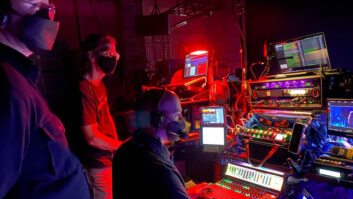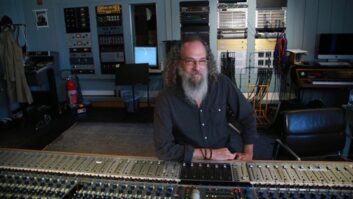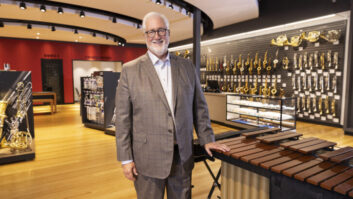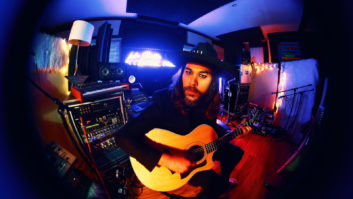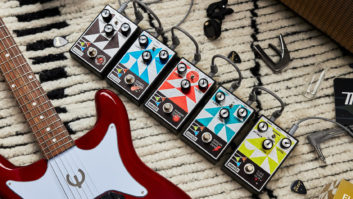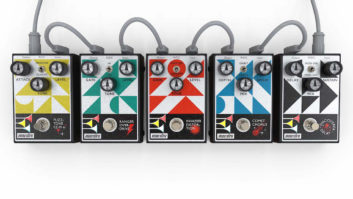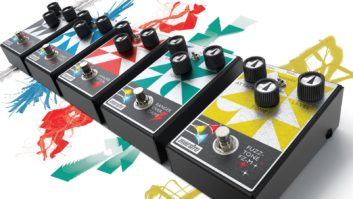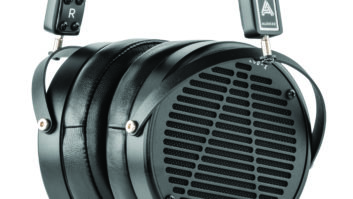When Sony and Philips laid the foundation for the Super Audio CD — the sound carrier based on their Direct-Stream Digital encoding process — they could not have envisioned a more ideal showcase for their fledgling product than the reissue of 22 classic Rollings Stones albums on Abkco Records.
Released en masse in August 2002 on dual-layer discs that feature SACD and Red Book streams, the Abkco Series encompasses the Stones’ ’60s and early ’70s catalog — considered by most fans and critics as the high-water mark in the band’s career. The titles include England’s Newest Hit Makers/The Rolling Stones, December’s Children (and Everybody’s), Let It Bleed and Beggars Banquet.
Overseen by Abkco senior VP Jody Klein for more than two years, the Stones campaign was researched, archived, restored, transferred, remastered and reissued by a small team of audio luminaries that included Abkco in-house engineer Teri Landi, Magic Shop owner/engineer Steve Rosenthal, Gateway Mastering & DVD president and chief engineer Bob Ludwig, and David Kawakami, director of Super Audio project for Sony Corp. of America.
The project began as a massive archiving operation to restore the Stones’ Abkco catalog to its full splendor and rectify problems with the materials’ earlier pressings. In particular, Abkco’s mid-’80s CD reissues of its Stones catalog — which were done with early transfer equipment — were widely criticized for their poor sound quality. Also, some of the vinyl editions were pressed from safety masters that were made at slightly incorrect speeds. The speeds were checked thoroughly and corrected for the current SACD/CD reissues, and the sound quality is markedly better.
Furthermore, there were inconsistencies between the British and American versions of some Stones records, like Out of Our Heads and Aftermath. For those, Abkco chose to reissue both British and U.S. versions. The first step in Abkco’s archiving project consisted of locating the masters — a monumental task in itself — and transferring them to the highest-quality analog and digital media available.
“Unlike The Beatles, who recorded mostly in one place under the supervision of men in white lab coats, the Rolling Stones recorded everywhere, using different producers and different tape formats and alignments,” says Klein. “We were pulling things from the UK and from various places in the U.S. — from barns, from the black market, even from eBay. It took us two years to put it all together.”
Luckily, the tapes were in remarkably good shape despite their age, the diversity of brands and the less-than-ideal environments in which some of them were stored.
“The Stones used varying kinds of tapes, like Scotch, EMI, Agfa, and most of them were in good condition,” says Steve Rosenthal. “We didn’t have to break out the convection oven to bake the tapes. We also had a lot of luck with tones.”
THAT MAGIC TOUCH
As the masters were collected, they were meticulously transferred at the Magic Shop in the Blue Room, a suite that Rosenthal — a veteran archivist who has done large-scale projects for Abkco and Smithsonian Folkways, among others — built to handle restoration and mastering work.
“We were determined to transfer this material only once and go to three formats with it,” says Klein. “We wanted to go to half-inch, 30 ips analog tape. Then there was the PCM world, which we knew how to do. And then there was this DSD thing, which I’d heard about. We set up a chain where we could listen to all three. We played the analog against the original master as it was transferring, and it sounded okay; the PCM was better. The DSD button didn’t work, because I didn’t hear any difference between the source and the DSD! Then, I finally got it. The DSD sounded like it didn’t work because it was exactly like the master.”
The three destination recorders were the Magic Shop’s Ampex ATR-102, a Sonic Solutions 24-bit 96kHz system with Mytek converters and a Sonoma DSD workstation with Ed Meitner converters. The switching system that allowed the engineers to toggle between each format at the monitoring level — and perform all three transfers simultaneously — was also designed and built by Meitner.
A ROCK ‘N’ ROLL ARIA
The source deck was Abkco’s ATR-102, which is equipped with ¼-inch and ½-inch headblocks and custom Flux Magnetics heads. Rebuilt by ATR Service Co. president Michael Spitz, the Abkco unit features Aria Reference Electronics, an all-discrete, Class-A package designed by David Hill (of Summit and Crane Song fame) with Spitz. Ludwig, who mastered the entire collection after it was transferred at the Magic Shop, raves about the Aria system’s sonic properties. “Whenever I’m A/B’ing between tubes and solid-state, I think, ‘Give me the bass of the tubes and the speed of the solid-state,’” says Ludwig. “These are the first electronics that do that.”
Spitz adds, “This is one of the most intense design projects Dave Hill has done to date. It blends the best of analog and the best of digital. It features a separate power supply, which gives us a bit more noise and hum immunity from the electronics, and it also sports quite a bit more record and playback headroom than what’s been previously available. We feel that this is the evolutionary step that has not happened since 1986.”
The project’s archive, restoration and transfer phases allowed Klein’s team to “restore the original albums to the way they once were,” as he puts it.
Although SACD allows for multichannel streams, Klein did not want to reinvent the Stones catalog for surround sound. He says, “Where stereo was stereo, we put stereo back. We got rid of all the reprocessed electronic stereo and replaced it with mono.”
Along the way, the engineers made startling discoveries. For instance, Landi noticed that the version of Let It Bleed that came out on both vinyl and CD was cut from a safety of the master, which was made on a machine that played slightly faster. Accordingly, the finished record played back at a slightly lower speed than what was intended by the band and original album producer Jimmy Miller.
“For two days after we discovered this, I wouldn’t let anyone speak about it, because it was just too mind-blowing,” says Klein. “So we went back to the singles, because those were cut at the right speed, and, sure enough, the singles matched the master. But it was still too big of a mistake to have been made, so we wanted to be extra sure. I remembered that the recording of ‘Sympathy For the Devil’ had been filmed for the Jean-Luc Godard movie Sympathy For the Devil, So we went back to the Nagra tapes, which had to be in sync because they matched the picture. Again, they matched the original album. At that point, we decided that’s what we would go with. It wasn’t slowed down for any artistic reason; it was a mistake.”
RESPECTING THE ORIGINAL MASTERS
The transferred masters were brought to Ludwig’s Gateway complex in Portland, Maine, where the veteran engineer methodically compared them to previously released versions of every song.
“On every single song, we had all of the original pressings — some mega-valuable pressings of these things, like the Ffrr recording of December’s Children from Decca, which is worth hundreds of dollars,” says Ludwig. “We compared every version, sometimes the single and the album cuts if we were working on the album or the previous CDs that Abkco did. The thing that really checked out was the singles; they were considered the Gold standard. The speed of the singles was right, and whatever was on the singles is what the producers [i.e., Miller, Andrew Loog Oldham, Glyn Johns and the Stones themselves] had really liked.”
Some of the singles were extremely bright because they were cut for AM radio. Ludwig decided to respect the originals, even if they were mastered differently than the way he might have done them.
“Sometimes, I’d do what I thought was a good EQ, and then I’d put the record on and it was like, ‘Whoa, they got a hell of a lot of vocal EQ out of that, boosting the midrange like crazy!’ I wouldn’t have thought to have done that much, but that’s what came out at the time. That’s what they were thinking, and that’s, in fact, what people grew up with. For this project, I had to respect that.”
Ludwig kept his use of compression to a minimum: “We used as much compression as was needed to make it sound like the original, but in no case did we over-compress anything by a long shot. In fact, a lot of the cuts do not have compression on them at all. The idea was to have a really good-quality version of what they originally did.”
For the downsampled CD versions of the reissues, Ludwig used Sony’s new Super Bit-Mapping Direct process, now available as a software option on the Sonoma.
“The SACD is the Rosetta Stone that represents the ultimate quality, and the SBMD can downsample from it to almost anything in the PCM world,” says Ludwig. “It’s the best downsampler I’ve heard.”
Klein adds that SBMD gave him the confidence of knowing that the CD versions of the reissues — which are the ones the majority of the record-buying public will hear, at least initially — represent the highest-quality, 16-bit audio that can be achieved. He says, “It’s the best-sounding CD that you can buy today, and it’s the best-sounding disc that you don’t have to buy for the future.”
TWO FORMATS, ONE DISC
From a manufacturing perspective, the Stones series — which is distributed by Universal Music — presented a unique challenge because of the volume needed to fill the global demand for the product vs. the relatively small number of plants equipped to make SACD hybrid discs.
Asked why he chose SACD over DVD-Audio, Klein says that he wanted to avoid having to issue separate CD and high-resolution versions of each title. Because the DVD-Audio specification does not allow for simultaneous Red Book and uncompressed DVD-Audio streams, his only choice for a single-inventory release was SACD. Plus, he adds, the simplicity of SACD appealed to him.
“Because the marketplace is so confused right now with all of these different mediums, the consumers have to be doubly confused,” he observes. “They’ve had a lot of things thrown at them — MD, DCC, DAT, CD ripping, MP3, etc. They don’t know what to make of all that. Our philosophy is simple: You don’t have to know what you’re buying; that’s not important. What’s important is it fits in your player, and it sounds incredible. And then, you open up your CD jacket and read about this new technology, which is the reason it sounds so good. And you realize that, with the next player you get, it’ll sound even better.”
Once Klein decided to run with SACD, he approached Sony Corp. with a marketing proposition. David Kawakami, director of the Super Audio project for Sony Corp. of America, recalls, “Jody threw down the gauntlet and said, ‘If you think this is important and it could help your format, why don’t you make us a proposal that involves leveraging what your electronics company can bring in terms of copromoting it and lifting it above the level of just another reissue series?’ So we went to Sony Electronics and they were very excited. They recognized that this was a good opportunity — something that mass-market retailers could get behind. The [SACD] players were already cheap, the distribution was in place, and this was the perfect vehicle on so many levels, especially with the Stones going on tour in the fall of 2002.”
The Stones campaign broke with the pattern whereby a high-profile Sony Music title would appear on CD and later, separately, on SACD. If the CD sold in the millions, the SACD would typically sell in the tens of thousands, according to Kawakami. “This is the reverse case,” he says. “It’s marketed as a CD and it’s the same price as a CD, but it’s an SACD. It’s reverse stealth. It allows us to whisper in the ears of millions of consumers.”
SACD FOR THE MASSES
The mass-market appeal of the Stones should help Sony augment the audiophile base it has already established with SACD.
A further element in the marketing campaign for the Stones titles is the idea that they may represent an answer to the industry’s business woes. Klein explains: “We are concerned about the way the music business is going and the way copyrights are going. Piracy is terrible. But instead of going around and crying about it, we asked ourselves, ‘Why aren’t consumers buying our product?’ Well, if you want to think in the commercial sense, the reason consumers aren’t buying our product is that they can get it for free. So, we have to sell something they can’t get for free, and they can’t get this for free. There’s a value to what they’re buying. The down market is forcing the majors to take another look at SACD and say, ‘Well, maybe chasing this phantom business model of electronic downloading is never going to pan out. We’re getting killed by the perception that you can rip and burn music for free. Maybe the answer is packaged media that we can sell.’”
Kawakami cites an e-mail from a consumer who had been listening to the Stones SACDs at home and in his car CD player. Then, the consumer decided to make MP3 files of the CDs so that he could play them on his computer, but decided that they weren’t worth listening to in a compressed format. Kawakami says, “I sent that post to Jody saying, ‘Eureka! Herein lies the problem — and the solution.’”
AN SACD PRIMER
The Super Audio CD (SACD) is a second-generation consumer sound carrier based on Sony’s and Philips’ Direct-Stream Digital (DSD) encoding process, a 1-bit digital audio system with a sampling rate of 2.8224MHz.
SACD’s physical dimensions are identical to that of a conventional “Red Book” CD — ensuring backward-compatibility between the formats — but in other respects, the two products are different. SACD has a “hybrid” architecture, meaning that two distinct data streams — a high-resolution DSD bitstream and a standard-CD Red Book stream — can be encoded on two separate layers of the disc. An SACD player distinguishes between the two and plays whichever one is chosen by the user. When placed in a standard CD player, the laser reader sees through the high-resolution layer only to read the standard Red Book layer, which is encoded at the standard rate of 16 bits sampled at 44.1kHz.
The data “pits” of the SACD layer are smaller and closer together than those of the CD, allowing up to eight audio channels (two for stereo and up to six for multichannel) to be packed onto the high-resolution layer. In this respect, the pit structure greatly resembles DVD, with a capacity of 4.7 GB per layer available to accommodate the high-resolution audio.
SACD’s underlying technology, DSD, differs substantially from pulse-code modulation (PCM), the encoding process used for CD and most professional digital audio systems. Whereas PCM requires each digital audio sample to undergo a complex mathematical conversion, DSD streamlines the process by eliminating the “decimation” and “interpolation” stages. The result, argue DSD proponents, is a more direct digital representation of the original analog waveform that can reproduce the “air” and “warmth” associated with high-quality analog recording.
In many regards, SACD resembles DVD-Audio, the other leading successor of CD. However, there are important technical differences between the two formats. Whereas DVD-A employs PCM technology — with word lengths of up to 24 bits and sampling rates of up to 192kHz — SACD is based on the single-bit DSD architecture. Also, while SACD stresses CD compatibility by allowing high-resolution and Red Book audio streams on the same disc, DVD-Audio does not offer Red Book as an option in conjunction with DVD-Audio. In other words, if producers wanted to release an album on DVD-Audio and CD, they would have to issue two separate discs.
DVD-A can, however, deliver a layer of uncompressed, multichannel audio (using a technology called Meridian Lossless Packing) and a layer of multichannel audio compressed with Dolby AC-3. Using this approach, DVD-A has staked its claim among home-theater enthusiasts whose DVD players are equipped to play AC-3 audio.
Since SACD was introduced in 1999, the format’s hardware has undergone a drastic price reduction, from a whopping $5,000 for the early players to the $200 range for the latest generation. As a sign of its intention to maintain compatibility with the 500 million CD players in existence, Sony has added SACD playback capability to most of its CD, DVD-Video and “home-theater-in-a-box” products. Some industry observers say that the fate of SACD and DVD-Audio will rest on the success of truly universal units that can play all formats: CD, SACD, DVD-Audio and DVD Video.
— Paul Verna
